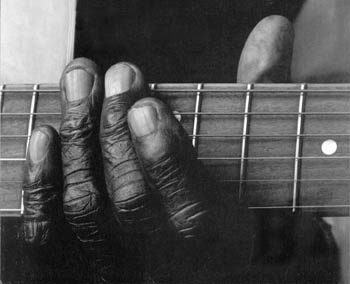The blues is one of my favorite genres on guitar, I teach it to students all the time.
Why?
Because it's easy and loads of fun. If you're at an intermediate level, you're already at a stage where you can play astonishing blues riffs and solos like BB himself if you know some basic blues guitar techniques.
And you know what, these blues techniques are mostly basic guitar techniques that you are probably familiar with already. If you can already play some of the more complicated songs in the guitar song lessons section of the site, you are at the stage where you might consider getting some blues guitar lessons, since you are already at the level where you could be playing the blues.
But enough rambling, here are the guitar techniques you'll need to master if you want to play blues:
Bending to and from notes
Bending strings is one of the most important techniques in blues guitar, and it’s also one of the easiest ways to make your playing sound expressive and "vocal."
For this reason, blues uses LOTS of string bending, you'll need to practice them a lot.
It's tough on your fingertips at first, but it'll all be easier with time.
When you're playing slow blues, you'll be bending up to the note you are aiming for a bit slowly, thus giving it the expressive feel that is very typical of blues.
Bend intervals
Where you bend to also matters, you want to stay within the key you are playing in:
- Half-step bends are when you push a note up to the very next fret’s pitch, for example, from fret 7 on the G string to the pitch of fret 8. You’ll hear these a lot when bending from the flat 7th to the root or from the minor 3rd to the major 3rd.
Also, bending to the blues note on the minor pentatonic blues scale sounds great. - Whole-step bends go two frets higher in pitch.
Stick with your minor pentatonic scale pattern, meaning you can bend from the flat 3rd, 4th, and flat 7th to the noext notes in the scale. - Pre-bends are a secret weapon for soulful blues playing. You bend the string before you pick it, holding it at the higher pitch, then let it release back down. This is perfect for mimicking the way singers scoop into a note.
A great way to make bends even more emotional is by adding vibrato at the top of the bend, which is a more advanced technique.
When bending, always use support fingers behind your bending finger to help push the string to increase the strength and keep control over the bend.
So as an example, this means that if you’re bending with your ring finger, place your index and middle fingers one and two frets below on the same string to help.
Tip: Always check your intonation, to make sure the note you are bending to is spot on. Play the target note normally and then bend up to it so your ear gets used to the exact pitch.

Shake the string (aka vibrato)
The vibrato might just be the single most expressive technique in your arsenal. You can literally recognize players like BB King through their vibrato.
Use it, and use it a lot when playing the blues.
There are 2 important things to keep in mind:
- Use your wrist, not fingers: Anchor the thumb over the top of the neck and use a gentle wrist motion to rock the string, rather than moving your finger up and down alone. This keeps the pitch smooth and controllable.
- Width and speed: Begin with a narrow vibrato (just a slight pitch change), then experiment with wider vibrato for dramatic BB King style moments. Keep the speed steady; aim for a relaxed, singer-like pulse, not a nervous wobble.
Vibrato is the blues guitarist’s fingerprint, use it.
Sliding
Blues guitarists don't just simply pluck a note, they sometimes slide into it. Sliding into notes is very typical in blues as well, and just adds character and a bluesy feel to the riff.
You can use them to connect your phrases and minor pentatonic shapes, and slides between positions on the same string to glue licks together.
You can use:
- Ascending slides (up the neck): Pick the first note, then press and slide to the target fret in one motion. Aim to land right on the beat with the target note so it feels intentional, not late.
- Descending slides (down the neck): Start on the higher fret, pick once, and glide down to the lower fret. Keep the pressure even so the sound doesn’t choke out.
Slurring
This is a technique that is utilized mostly in blues, and not in other genres. When slur a note, you bend it just slightly, right before plucking a new note.
They are not full-on bends within your scale, rather just small tonal plays that a singer might use.
Slurs are actually one of the most characteristic sounds of blues, so using them is imperative.
Hammering on and pulling off of notes
The hammer-on and pull-off is used very often in fast blues, so get used to it.
As with bends and slides, make sure you stay within the scale you are playing in.
Phrasing the blues
Blues players enjoy a sort of rhythmic liberty in the sense that they allow certain notes to be played off rhythm.
Great blues solos sound like a conversation, not a scale exercise. Think in short, singable sentences, leave space to breathe, and line up strong notes with the groove.
For example:
- Entering: When a blues guitarist enters, he will typically start a half beat after the bar starts.
- Silence: It's ok to "leave space", gaps of silence when playing blues lead, you don't need to fill every beat.
- Call and response: Play a short “question” phrase, pause for a beat or two, then answer it with a slightly different “response.” Keep the rhythm consistent between the two so it feels like a conversation, not two random licks.
- Repeat with variation: Play the same idea again an octave higher or tweak one note/rhythm so it evolves without losing the hook. This instantly adds structure and keeps the listener engaged.
Listen and practice
The techniques required for playing blues guitar are easy, the challenge is using them expressively. A vibrato is not just a vibrato in blues, it's an expression of your soul, along with all the other techniques above.
Here's a good tip if you want to start playing blues:
Start listening to as much blues guitar music as you can. Check out this post on the best blues guitarists in the world, download some of their albums, and just listen for how they use the blues techniques you are now familiar with.





nice tips sir.. it make me understand about blues..!!
thank you